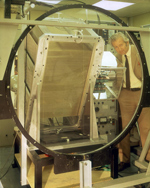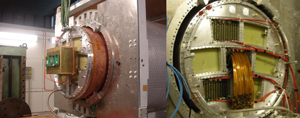 |
 |
|||||||||||||
|
|||||||||||||
|
|||||||||||||
|
It's hard to imagine a particle physics experiment that wouldn't use one of his concepts. Georges Charpak, Nobel Prize-winning physicist, passed away last week. Particle physicists owe him a lot, and so does the general public, since his inventions yield applications in many other fields that use ionising radiation such as biology, radiology and nuclear medicine. Georges Charpak, CNRS then CERN experimental physicist, revolutionised particle detection in 1968 and was awarded the Nobel Prize in physics in 1992 "for his invention and development of particle detectors, in particular the multiwire proportional chamber." Before he proposed this new detector, particle physicists were thrilled by the bubble chamber, though analysing data at that time was fastidious, requiring loads of manpower. Charpak took advantage of the development of electronics to develop a new ionisation detector that combined the technology of tube detectors (like the Geiger-Müller counter) with proportional counters for energy measurement. His historical 100-square-centimetre detector was able to detect one million particle events per second when former one-square-metre proportional chambers could count only one hundred. Thanks to multiwire chambers and its daughters that equipped from then nearly all detectors, major discoveries and observation in particle physics followed, from Z and W bosons in 1983 at CERN to the top quark at Fermilab in Chicago. With Charpak's new detector particle physics entered a new era. Three of the four experiments of the Large Hadron Collider, currently the world's most powerful particle accelerator, are using chambers that derive more or less directly from Charpak's invention. Even though silicon detectors are now faster than multiwire chambers, experimentalists still use them for their big advantages: they can equip very large detection planes and bear a very high flux of particles. In the ALICE experiment, the muon spectrometer consists of a nearly 100-square-metre multiwire chamber equipped by 1.1 million readout channels. Multiwire chambers are also used for event triggering, which will allow for example the ATLAS experiment to reduce the initial rate of 40 million collisions per second (in the foreseen high-luminosity mode) down to 200 "interesting" collisions. “It is fair to say that without the developments pioneered by him, particularly the invention of the multi-wire proportional chamber in 1968, much of the LHC programme would not be possible today,” said Rolf Heuer in last issue of the CERN Bulletin. “Actually, all of Charpak's work on multiwire proportional chambers has had a big impact on gaseous detectors since then,” said Jan Timmermans from Nikhef, who works on the ILC Time projection Chamber group at DESY, Germany. Charpak himself continued with the development of drift chambers. In particular he added cathode strips perpendicular to the anode wires which made it possible to reconstruct the particle tracks in three dimensions by measuring the drift time of the primary ionisation electrons towards the anode wires. Though Charpak didn't invent the Time Projection Chamber (TPC) in the late 70s himself (it was invented by David Nygren at Berkeley), this big-volume gaseous tracking detector is a direct heritage of Charpak's concepts. It consists of a gas-filled cylindrical chamber with multiwire proportional chambers as endplates for charge multiplication. TPCs were widely used in past experiments like PEP4 at SLAC, US or ALEPH and DELPHI at CERN. Currently, ALICE at CERN hosts the largest TPC ever built.
“For the ILC though, we are looking into a different direction for gas amplification, because of the high challenges,” said Timmermans. Thanks to its high luminosity, to well defined interaction parameters and to operating conditions which are much less demanding than for hadron colliders, the ILC allows for an unprecedented sensitivity to physical processes. “The drawback – or better, the challenge – is that space and time resolutions of particle tracks need to be unprecedentedly high. The other challenge is the collision rate. Therefore a new amplification technique is needed in Time Projection Chambers and scientists are now developing what they call 'micro-pattern gas' detectors.” Two different technologies of micro-pattern devices are under investigation for their use in a TPC at the International Large Detector, which are the Micro Mesh Gaseous Detectors (Micromegas) and Gas Electron Multipliers (GEMs). Charpak, together with Ioannis Giomataris from CEA, France, also initiated the work on Micromegas sensors. Fabio Sauli from CERN invented GEMs. Charpak also developed detectors for biological research based on his multiwire chamber that could eventually replace photographic recording in applied radiobiology. The increased recording speeds translate into faster scanning and lower body doses in medical diagnostic tools based on radiation or particle beams. He participated in many other particle detector developments, trying each time to find other fields of applications. And the story goes on... For the ILC TPC, the development studies pursued on GEMs and Micromegas already benefit to both particle physics and medical research communities. -- Perrine Royole-Degieux
Further reading
TPC: a digital breakthrough (ILC NewsLine – 1 November 2007) Large TPC prototype field cage arrives for testing (ILC NewsLine – 28 August 2008) The LCTPC (Time Projection Chamber for a future Linear Collider) collaboration website |
|||||||||||||
| © International Linear Collider |

